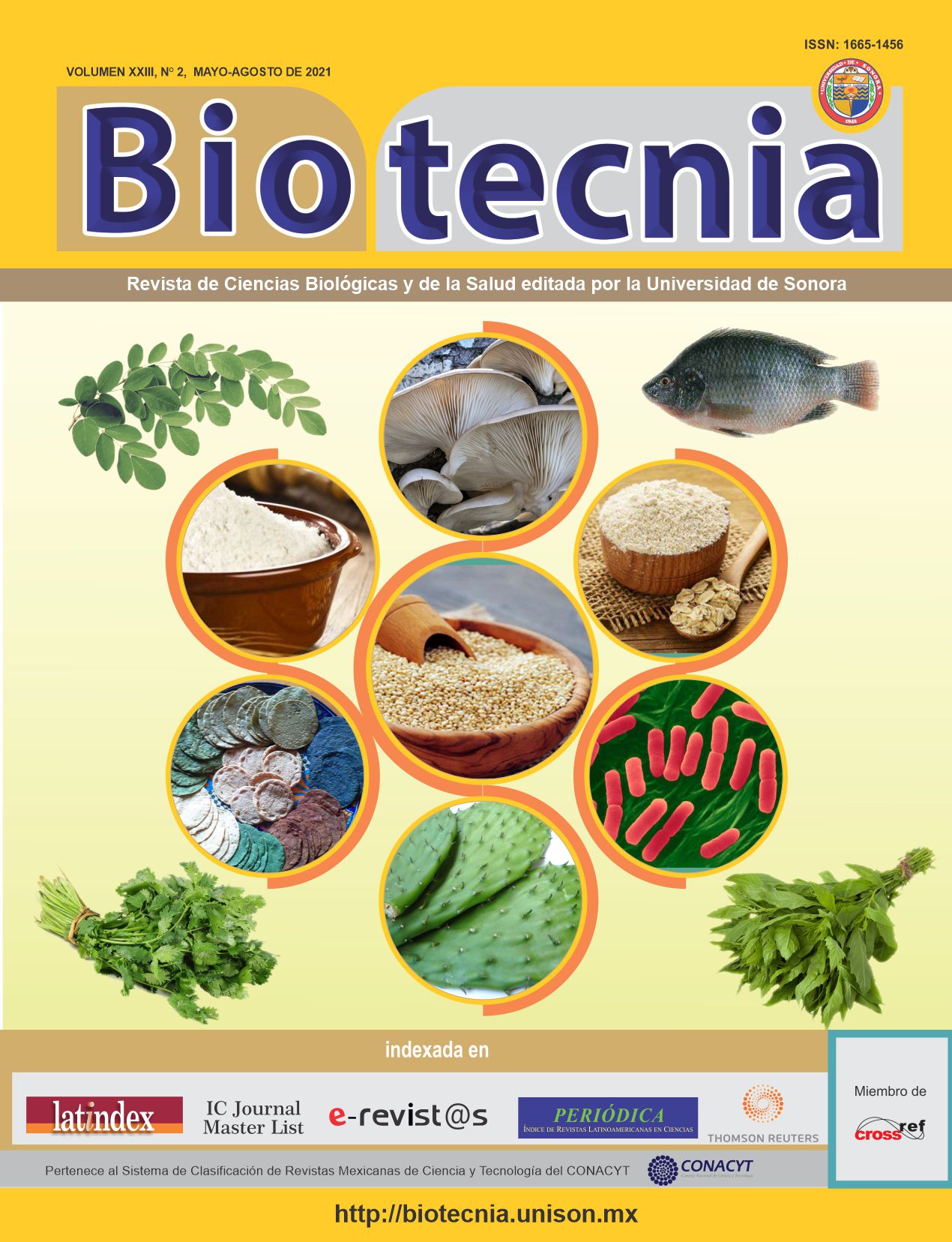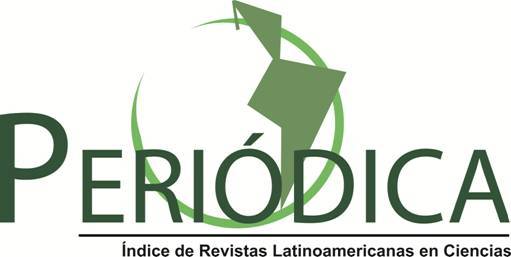Expresión diurna y estacional del gen hsp70 en un pez críptico arrecifal, el gobio azul rayado Lythrypnus dalli (Gilbert 1890)
DOI:
https://doi.org/10.18633/biotecnia.v23i2.1410Keywords:
circadian rhythm, cryptic reef fish, heat shock protein 70, Lythrypnus dalli, temperatureAbstract
Physiological responses of marine organisms are influenced by environmental variations, particularly in dynamic habitats. These variations could be at a diel or seasonal scale and require acclimation responses that, at a molecular level, are facilitated by gene expression regulation. Circadian rhythms allow organisms to adjust to recurring environmental changes and to synchronize physiological processes. Increased Hsp70 gene expression allows organisms to protect themselves against heat and other stressors, conferring them a periodically changing thermotolerance. This study aimed at analyzing whether the variability of exogenous factors (temperature, dissolved oxygen, salinity) in diurnal or seasonal scales affects hsp70 expression in cryptic reef fishes in their natural environment. The study model was Lythrypnus dalli, an endemic cryptic reef fish inhabiting shallow waters throughout the Gulf of California. Physical parameters varied seasonally; temperature increased 6°C during the warm season, salinity and dissolved oxygen remained constant. Minimal changes in temperature (±1 °C) occurred diurnally. Expression levels of hsp70 increased significantly during the warm season (p < 0.05), perhaps related to seasonal thermal changes. No differences in hsp70 were observed during the diurnal cycle (p > 0.05). L. dalli has apparently developed phenotypic plasticity to face environmental variability at diurnal and seasonal scales.
Downloads
References
Brandl, S.J., Goatley, C.H.R., Bellwood, D.R. y Tornabene, L. 2018. The hidden half: ecology and evolution of cryptobenthic fishes on coral reefs. Biol. Rev. 93: 1846-1873. doi:10.1111/brv.12423
Buckley, B.A. y Hofmann, G.E. 2002. Thermal acclimation changes DNA-binding activity of heat shock factor 1 (HSF1) in the goby Gillichthys mirabilis: implications for plasticity in the heat-shock response in natural populations. J. Exp. Biol. 205: 3231-40.
Chomczynski, P. y Sacchi, N. 1987. Single-step method of RNA isolation by acid guanidinium thiocyanate-phenol-chloroform extraction. Anal. Biochem. 162: 156-159. doi:10.1006/abio.1987.9999
Culumber, Z.W., Shepard, D.B., Coleman, S.W., Rosenthal, G.G. y Tobler, M. 2012. Physiological adaptation along environmental gradients and replicated hybrid zone structure in swordtails (Teleostei: Xiphophorus). J. Evol. Biol. 25: 1800-1814. doi:10.1111/j.1420-9101.2012.02562.x
Dietz, T.J. 1994. Acclimation of the threshold induction temperatures for 70-kDa and 90-kDa heat shock proteins in the fish Gillichthys mirabilis. J. Exp. Biol. 188: 333-8.
Evans, T.G. y Hofmann, G.E. 2012. Defining the limits of physiological plasticity: how gene expression can assess and predict the consequences of ocean change. Philos. Trans. R. Soc. B Biol. Sci. 367: 1733-1745. doi:10.1098/rstb.2012.0019
Feder, M.E. y Hofmann, G.E. 1999. Heat shock proteins, molecular chaperones, and the stress response: evolutionary and ecological physiology. Annu. Rev. Physiol. 61: 243-282.
Feidantsis, K., Antonopoulou, E., Lazou, A., Pörtner, H.O. y Michaelidis, B. 2013. Seasonal variations of cellular stress response of the gilthead sea bream (Sparus aurata). J. Comp. Physiol. B 183: 625-639. doi:10.1007/s00360-012-0735-y
Guerriero, G., Bassem, S.M., Khalil, W.K.B., Temraz, T.A., Ciarcia, G. y Gawad, F.K.A. 2018. Temperature changes and marine fish species (Epinephelus coioides and Sparus aurata): Role of oxidative stress biomarkers in toxicological food studies. Emirates J. Food Agric. 30: 205. doi:10.9755/ejfa.2018.v30.i3.1650
Gunderson, A.R., Armstrong, E.J. y Stillman, J.H. 2016. Multiple Stressors in a Changing World: The Need for an Improved Perspective on Physiological Responses to the Dynamic Marine Environment. Ann. Rev. Mar. Sci. 8: 357-378. doi:10.1146/annurev-marine-122414-033953
Habary, A., Johansen, J.L., Nay, T.J., Steffensen, J.F. y Rummer, J.L. 2016. Adapt, move or die - how will tropical coral reef fishes cope with ocean warming? Glob. Chang. Biol. 566-577. doi:10.1111/gcb.13488
Harborne, A.R. 2013. The ecology, behaviour and physiology of fishes on coral reef flats, and the potential impacts of climate change. J. Fish Biol. 83: 417-447. doi:10.1111/jfb.12203
Hassan, A., El Nahas, A.F., Mahmoud, S., Barakat, M.E. y Ammar, A.Y. 2017. Thermal stress of ambient temperature modulate expression of stress and immune-related genes and DNA fragmentation in Nile tilapia (Oreochromis niloticus (Linnaeus, 1758)). Appl. Ecol. Environ. Res. 15: 1343-1354. doi:10.15666/aeer/1503_13431354
Heredia-Middleton, P., Brunelli, J., Drew, R.E. y Thorgaard, G.H. 2008. Heat shock protein (HSP70) RNA expression differs among rainbow trout (Oncorhynchus mykiss) clonal lines. Comp. Biochem. Physiol. - B Biochem. Mol. Biol. 149: 552-556. doi:10.1016/j.cbpb.2007.05.012
Hoey, A., Howells, E., Johansen, J., Hobbs, J.-P., Messmer, V., McCowan, D., Wilson, S. y Pratchett, M. 2016. Recent Advances in Understanding the Effects of Climate Change on Coral Reefs. Diversity 8: 12. doi:10.3390/d8020012
Hofmann, G.E. 2005. Patterns of Hsp gene expression in ectothermic marine organisms on small to large biogeographic scales. Integr. Comp. Biol. 45: 247-255. doi:10.1093/icb/45.2.247
Illing, B. y Rummer, J.L. 2017. Physiology can contribute to better understanding, management, and conservation of coral reef fishes. Conserv. Physiol. 5: 1-11. doi:10.1093/conphys/cox005
Jesus, T.F., Inácio, Â. y Coelho, M.M. 2013. Different levels of hsp70 and hsc70 mRNA expression in Iberian fish exposed to distinct river conditions. Genet. Mol. Biol. 36: 061-069. doi:10.1590/S1415-47572013000100009
Kwiatkowski, L., Gaylord, B., Hill, T., Hosfelt, J., Kroeker, K.J., Nebuchina, Y., Ninokawa, A., Russell, A.D., Rivest, E.B., Sesboüé, M. y Caldeira, K. 2016. Nighttime dissolution in a temperate coastal ocean ecosystem increases under acidification. Nat. Publ. Gr. 1-9. doi:10.1038/srep22984
Levy, O., Kaniewska, P., Alon, S., Eisenberg, E., Karako-Lampert, S., Bay, L.K., Reef, R., Rodriguez-Lanetty, M., Miller, D.J. y Hoegh-Guldberg, O. 2011. Complex Diel Cycles of Gene Expression in Coral-Algal Symbiosis. Science (80-.). 331: 175-175. doi:10.1126/science.1196419
Lewis, M., Götting, M., Anttila, K., Kanerva, M., Prokkola, J.M., Seppänen, E., Kolari, I. y Nikinmaa, M. 2016. Different Relationship between hsp70 mRNA and hsp70 Levels in the Heat Shock Response of Two Salmonids with Dissimilar Temperature Preference. Front. Physiol. 7: 1-12. doi:10.3389/fphys.2016.00511
Logan, C. A. y Somero, G.N. 2011. Effects of thermal acclimation on transcriptional responses to acute heat stress in the eurythermal fish Gillichthys mirabilis (Cooper). Am. J. Physiol. Regul. Integr. Comp. Physiol. 300: R1373-R1383. doi:10.1152/ajpregu.00689.2010
Lund, S.G., Caissie, D., Cunjak, R.A., Vijayan, M.M. y Tufts, B.L. 2002. The effects of environmental heat stress on heat-shock mRNA and protein expression in Miramichi Atlantic salmon (Salmo salar) parr. Can. J. Fish. Aquat. Sci. 59: 1553-1562. doi:10.1139/f02-117
Ma, F., Liu, Z., Huang, J. Q., Kang, Y. J. y Wang, J. F. 2019. Evaluation of reference genes for quantitative real‐time PCR analysis of messenger RNAs and microRNAs in rainbow trout Oncorhynchus mykiss under heat stress. Journal of Fish Biology. 95(2): 540-554 doi:10.1111/jfb.13986
Madeira, D., Narciso, L., Cabral, H.N., Vinagre, C. y Diniz, M.S. 2012. HSP70 production patterns in coastal and estuarine organisms facing increasing temperatures. J. Sea Res. 73: 137-147. doi:10.1016/j.seares.2012.07.003
Martínez-Flores, G. 2007. Caracterización de la temperatura superficial del mar y climatología de la Bahía de La Paz, B.C.S., México 21: 81-91.
Martínez-López, A., Cervantes-Duarte, R., Reyes-Salinas, A. y Valdez-Holguín, J.E. 2001. Cambio estacional de clorofila a en la Bahía de La Paz, BCS, Mexico. Hidrobiológica. 11 (1): 45-52. ISSN 0188-8897
Munday, P.L., Donelson, J.M. y Domingos, J.A. 2017. Potential for adaptation to climate change in a coral reef fish. Glob. Chang. Biol. 23: 307-317. doi:10.1111/gcb.13419
Nascimento, A.R., Silva, G.F., Gualberto, G.F. y Almeida, F.L. 2016. Validation of reference genes for real-time quantitative PCR in tambaqui (Colossoma macropomum). Genetics and Molecular Research. 15 (4): gmr15049228. doi: 10.4238/gmr15049228
Obeso-Nieblas, M., Shirasago, B., Sánchez-Velasco, L. y Gaviño-Rodriguez, J.H. 2004. Hydrographic variability in Bahia De La Paz, B. C. S, Mexico, during the 1997–1998 El Niño. Deep Sea Res. Part II Top. Stud. Oceanogr. 51: 689-710. doi:10.1016/j.dsr2.2004.05.005
Oren, M., Tarrant, A.M., Alon, S., Simon-Blecher, N., Elbaz, I., Appelbaum, L. y Levy, O. 2015. Profiling molecular and behavioral circadian rhythms in the non-symbiotic sea anemone Nematostella vectensis. Sci. Rep. 5: 11418. doi:10.1038/srep11418
Pfaffl, M.W. 2004. Quantification strategies in real-time PCR, A–Z of Quantitative PCR.
Podrabsky, J.E. 2004. Changes in gene expression associated with acclimation to constant temperatures and fluctuating daily temperatures in an annual killifish Austrofundulus limnaeus. J. Exp. Biol. 207: 2237-2254. doi:10.1242/jeb.01016
Pollock, M.S., Clarke, L.M.J. y Dubé, M.G. 2007. The effects of hypoxia on fishes: from ecological relevance to physiological effects. Environ. Rev. 15: 1-14. doi:10.1139/a06-006
Purohit, G. K., Mahanty, A., Mohanty, B. P. y Mohanty, S. 2015. Evaluation of housekeeping genes as references for quantitative real-time PCR analysis of gene expression in the murrel Channa striatus under high-temperature stress. Fish Physiology and Biochemistry, 42(1): 125–135. doi:10.1007/s10695-015-0123-0
Rummer, J.L., Couturier, C.S., Stecyk, J.A.W., Gardiner, N.M., Kinch, J.P., Nilsson, G.E. y Munday, P.L. 2014. Life on the edge: thermal optima for aerobic scope of equatorial reef fishes are close to current day temperatures. Glob. Chang. Biol. 20: 1055-1066. doi:10.1111/gcb.12455
Silver, J.T. y Noble, E.G. 2012. Regulation of survival gene hsp70. Cell Stress Chaperones 17: 1-9. doi:10.1007/s12192-011-0290-6
Tine, M. 2017. Evidence of the Complexity of Gene Expression Analysis in Fish Wild Populations. Int. J. Genomics 2017: 1-14. doi:10.1155/2017/1258396
Tomanek, L. 2010. Variation in the heat shock response and its implication for predicting the effect of global climate change on species’ biogeographical distribution ranges and metabolic costs. J. Exp. Biol. 213: 971-979. doi:10.1242/jeb.038034
Tunnah, L., Currie, S. y MacCormack, T.J. 2017. Do prior diel thermal cycles influence the physiological response of Atlantic salmon (Salmo salar) to subsequent heat stress? Can. J. Fish. Aquat. Sci. 74: 127-139. doi:10.1139/cjfas-2016-0157
Untergasser, A., Cutcutache, I., Koressaar, T., Ye, J., Faircloth, B.C., Remm, M. y Rozen, S.G. 2012. Primer3—new capabilities and interfaces. Nucleic Acids Res. 40, e115-e115. doi:10.1093/nar/gks596
Vaquer-Sunyer, R. y Duarte, C.M. 2008. Thresholds of hypoxia for marine biodiversity. Proc. Natl. Acad. Sci. 105: 15452-15457. doi:10.1073/pnas.0803833105
Veilleux, H.D., Ryu, T., Donelson, J.M., Ravasi, T. y Munday, P.L. 2018. Molecular Response to Extreme Summer Temperatures Differs Between Two Genetically Differentiated Populations of a Coral Reef Fish. Front. Mar. Sci. 5: 1-12. doi:10.3389/fmars.2018.00349
Vera, L.M., Negrini, P., Zagatti, C., Frigato, E., Sánchez-Vázquez, F.J. y Bertolucci, C. 2013. Light and feeding entrainment of the molecular circadian clock in a marine teleost (Sparus aurata). Chronobiol. Int. 30: 649-61. doi:10.3109/07420528.2013.775143
Yamashita, M., Yabu, T. y Ojima, N. 2010. Stress Protein HSP70 in Fish. Aqua-BioScience Monogr. 3: 111-141. doi:10.5047/absm.2010.00304.0111
Published
How to Cite
Issue
Section
License
Copyright (c) 2021

This work is licensed under a Creative Commons Attribution-NonCommercial-ShareAlike 4.0 International License.
The journal Biotecnia is licensed under the Attribution-NonCommercial-ShareAlike 4.0 International (CC BY-NC-SA 4.0) license.







_(1)_(1).png)






_(2).jpg)




